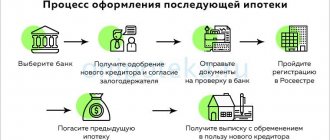A mortgage is an encumbrance of real estate with collateral. A mortgage is most often understood as an encumbrance in connection with obtaining a loan for the purchase of real estate. A mortgage loan secured by real estate can be issued in different ways: through a separate collateral agreement or by drawing up a real estate purchase and sale agreement, which will indicate the use of loan funds. The type of mortgage that arises depends on the choice of the method of registration of collateral.
Differences between mortgages arising by virtue of an agreement
When applying to a bank for a mortgage loan, a potential borrower can choose an object that will be provided to the bank as collateral for the loan: the property being purchased or an existing property. If the loan proceeds are used to purchase one property, and another is pledged as collateral, then there will inevitably be a need to draw up an additional agreement - a pledge (mortgage) for the property that will become collateral. In addition, a non-targeted loan can be secured by a mortgage agreement if required by the bank’s loan program.
The mortgage agreement may be drawn up not at the time of signing the loan agreement, but later (in this case, the loan agreement itself must contain a clause regulating the timing of the execution and registration of the encumbrance in the Unified State Register of Real Estate). In this case, the document may define the conditions under which the obligation to the lender to conclude a mortgage is considered fulfilled:
- from the date of signing the pledge agreement;
- from the date of submission of the registered mortgage agreement to the bank;
- from the date of provision of an extract from the Unified State Register of Real Estate, which reflects the encumbrance;
- from a different date (for example, provision of a registered contract and insurance).
The mortgage agreement comes into force from the moment of its state registration. Submission of documents for registration is carried out by both parties (or persons by proxy), and a state registration fee is charged.
Please explain to me what “MORTGAGE BY FORCE OF LAW” means.
«
Quote:
Mortgage by force of law on residential premises.
One of the developing areas of the real estate market is mortgages.
A mortgage is a security against real estate. A pledge, in turn, is one of the ways to ensure the fulfillment of an obligation of a monetary claim of a creditor (pledgee) to a debtor (pledger). Due to the fact that it makes it easier to enforce enforcement, collateral as a way to ensure proper performance of obligations is more attractive. A pledge implies that the debtor's property can be seized. In this case, the property on which the mortgage is established, as a rule, remains with the mortgagor in his possession and use.
If the debtor does not fulfill the obligation, foreclosure is applied to the real estate - it is sold, and the funds received from its sale are used to pay off the obligation.
The main legal acts that regulate mortgage issues are the Civil Code of the Russian Federation (hereinafter referred to as the Civil Code of the Russian Federation) and the Federal Law of July 16, 1998 No. 102-FZ “On mortgage (real estate pledge)” (hereinafter referred to as the Mortgage Law).
The current legislation, namely Article 334 of the Civil Code of the Russian Federation, provides for two types of grounds for the emergence of a mortgage:
1. by virtue of an agreement, i.e., subject to the conclusion of a pledge agreement;
2. by force of law, i.e., regardless of the conclusion of the mortgage agreement, but due to the circumstances specified in the law.
A mortgage by force of law arises upon the occurrence of certain facts specified in the law, upon the transfer of ownership of a real estate object from one person to another, as well as upon the acquisition of the right to a newly created real estate object.
A mortgage arises by force of law mainly in the following cases:
1. When alienating a property under a annuity agreement (Article 586 of the Civil Code of the Russian Federation), including under a contract of lifelong maintenance with dependents (Article 601 of the Civil Code of the Russian Federation).
2. When alienating a property under a contract for the purchase and sale of a property on credit, including with the condition of payment by installments, unless otherwise provided by the contract (Article 488 of the Civil Code of the Russian Federation).
According to paragraph 5 of Article 488 and paragraph 3 of Article 489 of the Civil Code of the Russian Federation, goods sold on credit, including with an installment plan, are recognized as being pledged by the seller from the moment it is transferred to the buyer to ensure the latter fulfills the obligation to pay, unless otherwise provided by the contract . This provision applies to all types of real estate that may be the subject of a purchase and sale agreement;
3. When purchasing or constructing residential premises using a loan from a bank or other credit organization or funds from a targeted loan provided by a legal entity for the acquisition or construction of a residential building or apartment, unless otherwise provided by law or agreement (Article 77 of the Mortgage Law).
Mortgage by virtue of the law of residential premises has a number of features. Mortgages of individual residential houses and apartments that are state or municipal property, as well as multi-apartment residential buildings, are not allowed.
Mortgage of a residential building or apartment owned by minors, persons with limited legal capacity or incapacitated persons over whom guardianship or trusteeship has been established, as well as alienation of residential premises in which family members of the owner of this residential premises live under guardianship or guardianship or those left without parental care minor members of the owner's family (which is known to the guardianship and trusteeship authority), if this affects the rights or interests protected by law of these persons, is allowed with the consent of the guardianship and trusteeship authority.
Unless otherwise provided by federal law or an agreement, a residential house or apartment acquired or built in whole or in part using credit funds from a bank or other credit organization or funds from a targeted loan provided by another legal entity for the purchase or construction of a residential house or apartment are considered to be in pledge from the moment of state registration of the borrower's ownership of a residential house or apartment.
Thus, in the above cases, the real estate is mortgaged by the bank that issued the loan, or another legal entity, the seller under the contract, or the recipient of the rent until the loan is fully repaid or another obligation is fulfilled.
A mortgage, by force of law, allows you to create additional guarantees for creditors (banks, sellers, rent recipients), expressed in the fact that they do not need to enter into an agreement with the debtor (buyer, rent payer) to secure their claims, and also achieve a certain flexibility in regulating property relations .
When state registration of a mortgage is required by law, it is not necessary to submit a corresponding (separate) application; such registration is carried out without paying a state fee.
If it is not possible to establish from the title document and other documents submitted for state registration of the right (transfer of right) that the real estate object is the subject of a mortgage arising on the basis of the law (for example, the purchase and sale agreement does not indicate that this object is being purchased for account of credit or borrowed funds) state registration of a mortgage by force of law is carried out on the basis of a joint application of the mortgagor and the mortgagee with the attachment of documents confirming the origin of the mortgage on the basis of the law. https://www.info.yarnet.ru/qa/index.php?id =42
Quote:
»
Subtleties of mortgages by force of law
When purchasing real estate using borrowed funds, the purchase and sale agreement includes provisions that the property is purchased with funds received by the buyer (or another person, if the buyer is not a borrower) from the lender under the loan agreement. Its details must be specified.
Such a mortgage arises from the moment of registering the DCT and entering information about the encumbrance in the extract from the Unified State Register.
Registration can be carried out by one of the parties to the contract with the provision of a full package of documents from the buyer and seller. Registration is possible upon the application of a notary who certified the DCP (certification is required if the agreement provides for an extrajudicial procedure for foreclosure on the pledge). The registration procedure is free for all parties.
Mortgage: by force of law, by force of contract - differences
So, how does a mortgage by force of law differ from a mortgage arising by virtue of an agreement:
| mortgage in effect | emergence | the subject of collateral may become | registration: 1 – when 2 – at the request of someone | state registration fee |
| law | automatically without the consent of the parties | loaned apartment | 1) simultaneously with state registration of property rights 2) can be carried out on the basis of an application from one of the parties to the transaction (mortgagee, pledgor, notary) | not charged |
| agreement | when drawing up a separate agreement | loaned or any other apartment owned by the borrower | 1) after registration of the purchase and sale agreement, on the basis of a separate mortgage agreement 2) carried out strictly on the basis of a joint application of the mortgagee and mortgagor | charged |
Termination of mortgage
Both types of property pledge assume that it secures a certain obligation of the pledgor to the pledgee (in rare cases, in complex transactions, the pledgee may be another person other than a bank, but such situations do not arise when lending to individuals). Therefore, the pledge, according to the Civil Code of the Russian Federation, terminates upon termination of the obligation that is secured by the pledge. In the case of a loan - when repaying the loan agreement.
An application for removal of the encumbrance can be submitted by one of the parties to the purchase and sale agreement or pledge. The bank only gives its written consent to the removal of the encumbrance in connection with the repayment of the loan agreement. The consent indicates the cadastral numbers of all mortgaged properties, data on the credit and mortgage agreement or DCT.
How is it different from a contractual mortgage?
Let us now understand where the line lies and what the main differences between a mortgage by force of law and by force of contract are expressed.
A mortgage loan by virtue of an agreement means a type of encumbrance that is not fully regulated by legislative acts. This most often happens in atypical situations when it is necessary to introduce many conditions, reservations, mutual requirements, etc. into the rights registration procedure.
Relatively speaking, a mortgage by force of law is when everything is extremely simple and all parties to the transaction act according to a scheme pre-established by law, but the same by force of contract is when the classical scheme is not suitable for a very unique case.
The basis for such a mortgage is a certain document establishing all the rights and obligations of the parties. Most often this is a purchase and sale agreement, but there may be variations. For example, a mortgage loan by virtue of an agreement is almost always concluded in the following cases :
- When the borrower places an encumbrance not on the property purchased on loan, but on housing that was owned by the citizen even before contacting the bank;
- When the transaction involves several parties that are not typical for lending - for example, the state partially subsidizes the purchase of housing (maternity capital, etc.);
- If the transfer of property rights must occur upon fulfillment of a certain condition - for example, the privatization of housing;
- The same thing, only with regard to the transfer of funds (down payment, first payment, full payment, etc., depending on the chosen loan/installment plan format).
Subsequent pledge
Subsequent collateral is the transfer of one object as collateral under several loan agreements. In the case of a mortgage by virtue of an agreement, the subsequent mortgage is formalized by a new mortgage agreement. The new document must include clauses about the previous encumbrance, indicating the registration entry in the Unified State Register, the date of occurrence of the encumbrance, the basis documents (number and date of the primary mortgage agreement) and the date of the extract from the Unified State Register, which confirms this information.
A subsequent pledge is not possible by law, since the DPA is concluded only once. If you need to take out another loan secured by the same real estate, then you need to take out a mortgage by virtue of an agreement. The registration procedure will be standard for a mortgage by virtue of an agreement. The text must also indicate the details of the contract and information about the previous encumbrance.
The initial and subsequent agreements must specify the same procedures for foreclosure of the collateral (either judicial or extrajudicial).
How to remove a mortgage encumbrance by force of law?
The encumbrance by force of law is the subject of the mortgage . The burden is removed from the borrower only when he fully pays off the mortgage with the bank. After making the last payment, the borrower must make sure that he has no more debt on the loan.
Removal of encumbrance is a free service. The borrower will have to visit Rosreestr with the necessary documents in order for the encumbrance to be removed from his property.
An employee of this organization accepts the client’s application and assigns him a date to appear. On the appointed day, the client comes to Rosreestr and receives an extract stating that there is no encumbrance.
If he receives a refusal, then he must be presented with a document indicating the reason for the refusal (for example, he has not fully repaid the mortgage).
What kind of real estate is subject to a mortgage by law?

By virtue of the law, a mortgage can arise on any real estate for the purchase of which banks are willing to provide loans. The most common collateral for mortgage transactions:
- apartment;
- a room in a multi-room apartment or dormitory;
- House;
- land plot;
- commercial real estate (office, retail, warehouse, production space);
- country house, garden house;
- garage, parking space.
If the mortgage borrower acquires an interest in the property, a lien will be placed on the entire property. For example, you decide to buy part of an apartment from relatives on credit. The bank will use as collateral not the share that you actually purchase, but the entire property.
Registration of mortgage by operation of law and repayment of record
State registration of a mortgage by force of law in Rosreestr occurs as follows:
- You have received approval from the bank for your mortgage application and are ready to enter into a deal. The loan specialist prepares all the necessary documents. As a rule, this is a loan agreement with a clause on the registration of collateral, a purchase and sale (or construction) agreement and a mortgage.
- The basis for registration of a pledge will be an application for registration of a mortgage by force of law from one of the parties to the credit transaction or the notary who registered the transaction. His participation is mandatory if you buy real estate in shared ownership.
- Registration of ownership and pledge in favor of the bank occurs within 5 days. After which they will issue an extract from the Unified State Register of Real Estate stating that you are now the owner of the property. The line on encumbrances will indicate a mortgage by force of law in favor of your creditor bank.
Please note that there is no state fee for registering a mortgage by law.
Separately, it is worth mentioning such an important document as a mortgage note by force of law. According to Federal Law N 102-FZ, it is not a mandatory condition for registering a mortgage transaction. To a greater extent, a mortgage is necessary for the bank to provide additional guarantee of debt repayment.
It is printed by the bank and contains the basic conditions for pledging real estate and repaying the loan debt. The borrower and other mortgagors (if any) put their signatures on it and submit it to Rosreestr together with other loan papers. The original document is kept in the bank's archives, and after the mortgage debt is paid off, it is issued to the property owner to remove the encumbrance.
Since 2020, bank clients have the opportunity to issue an electronic version of the document. The client and a representative of the credit institution fill out a special application on the Rosreestr website and certify it with electronic signatures. A mortgage issued in this way has a legal meaning similar to the paper version.
After full payment of the loan debt, the borrower should remove the encumbrance from the collateral property. This is the final stage of the mortgage. Removing the encumbrance is not so difficult:
- Receive a certificate from the bank about fulfilled obligations.
- Contact the Rosreestr office or the MFC with an application to repay the mortgage by force of law. If the personal presence of a bank representative is required, you need to coordinate with him the time of visiting the government institution. To remove the encumbrance, you need to take with you a certificate from the bank, a loan agreement, a mortgage and a passport.
- After 5 days, you will receive an extract from the register of rights, where the encumbrance in favor of the bank will no longer appear in the collateral line.
There is no need to remove the encumbrance the day after the mortgage is paid off. The certificate you will receive from the bank has no expiration date. You can address this issue at any time convenient for you. Now that you can submit documents to the MFC, the procedure for removing the collateral does not take much time. It is enough to visit the branch of the multifunctional center twice to submit an application and receive a “clean” extract.










